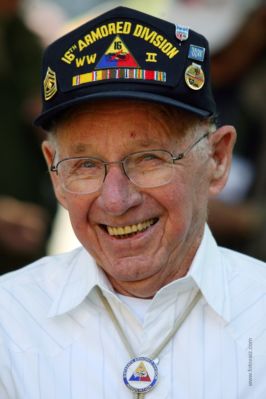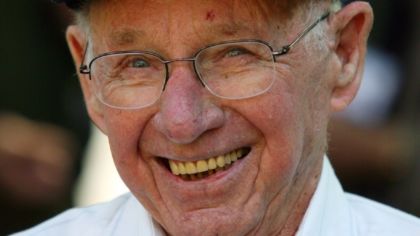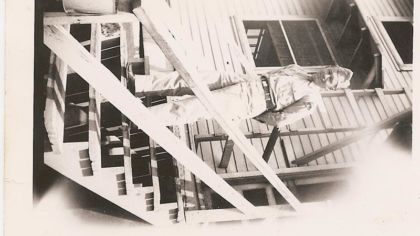George Thompson
Freedom is Not Free
George Thompson, former President, 16th Armored Division Association
I volunteered for Army service when I was 19 years old in May of 1943. After a very long time of training and going to schools at the Armored School in Ft. Knox, Kentucky, I was sent to my new Division, the 16th Armored. After more training on repairing tanks, trucks, half-tracks and Jeeps, we were finally ordered to ship out to France. After a very rough ride across the North Atlantic in February 1945, and being attacked by German submarines, we made it to Le Havre, France, in 12 days. Even though we reached the Le Havre harbor safely, we couldn’t reach the dock to unload – the harbor was filled with sunken ships, making it impossible to reach the docks until high tide.
After a few days in Le Havre, preparing our vehicles for the road and rail, we moved inland to Forges Les Eaux. My company stayed in a large old chateau. Some of the other men and I stayed out back in the barn loft. We stayed there repairing the division’s vehicles. While there, a request came down from General Patton that he wanted a more powerful Jeep. Some of our tech trucks had auxiliary Ford 100 horse power V8 engines in them, so we installed one of those in a Jeep and sent it back to him. I understand that, today, that Jeep is in the Patton Musuem in Fort Knox, Kentucky.
On about the 15th of April, we started to move up through France and Germany. We did so after being strafed and after coming under artillery fire, which struck a friend who was standing next to me, nearly severing his leg. We reached the place where we would jump off into Czechoslovakia at Fürth, Germany. As we advanced, our company was ordered to take the city of Nýřany, near Pilsen. We captured many Germans and sent them on to holding areas where they could be processed and sent home. While marching the prisoners down the street, the Czechs would beat them with whatever they could find. Our medics treated many more Germans for wounds than our own men. Although I understood the Czechs’ anger, I tried to prevent the beatings as best as I could.
After spending the night in Nýřany, we went directly to the Pilsen Airport… hundreds of captured German vehicles were parked there. All of them had been disabled by pulling the wires from under the instrument panel. As a mechanic, my job was to go down the line and start as many as possible. After we got them running, we turned them over to the City of Pilsen, for their use. We spent VE Day (Liberation Day) at the Pilsen airport with a bottle of German champagne that I had “liberated” back in Germany.
After VE Day, we were sent to Lestkov and later to Marienbad, then back to Regensburg, Germany. We weren’t in Czechoslovakia very long after the war’s end – I was sent home in May of 1946. I later married a girl with the last name of Havel – she and the war are my links to the Czechs. I first returned to the Czech Republic in 1991 and have been back many times since. I know of no other country where the people appreciate their freedom more than the Czechs.
“Remember – freedom is not free, but for the brave.”
From book 500 hours to victory


